Introduction
The purpose of all accident investigation is to establish the ’cause’ of the incident. This information will be sought for a number of reasons which may overlap. Thus the victims or their family will want to know why they were injured or killed, regulatory authorities may wish to establish responsibility and take appropriate action as a result and safety authorities will want to see what can be done to prevent a re-occurrence.
What do we mean by the cause of an accident and if it was caused by the actions or omissions of someone is it really an accident at all? The term ‘dangerous occurrence’ used in Health and Safety Regulations is in many ways more appropriate but the neutral term ‘incident’ will be used here. There can be several causes for one of these dangerous occurrences and the causes are often multilayered; the investigator needs to keep this firmly in mind when analyzing the data and reaching a conclusion. As always the investigator needs to have a clear understanding of the available evidence and what it means. An example from some years ago illustrates both of these points.
In 1975 a train on the London Underground ran into the blank wall at the end of the line at Moorgate Station. The immediate cause of the incident was the failure of the train to stop at the final station which was brought about because the driver did not obey the signals which controlled the speed of approach of the train. But why did the driver ignore these signals? There was alcohol in both the driver’s blood and the drink that he had with him when they were analyzed post mortem. An explanation for his actions perhaps? The driver, however, was an abstemious man and the incident happened early in the morning rush hour so, although not impossible, alcohol seemed an implausible explanation. Also as the incident occurred underground, the driver’s body was not recovered for several days and the temperature in the tunnel was elevated, the conclusion that postmortem putrefaction rather than antemortem drinking was the explanation for the presence of alcohol becomes more likely. This incident illustrates that sometimes the ultimate cause of a dangerous occurrence is never known.
Sources of information
Establishing the sequence of events which led up to an incident is usually an essential prerequisite for establishing why the incident happened. To do so successfully the investigator needs information and usually the more information the better. Although this can lead to problems of assimilation, arbitrarily excluding some sources or types of information runs the risk of excluding the vital fact which enables an investigator to unravel the puzzle. Information can be obtained from many sources each with its own advantages and disadvantages all of which need to play a part in the interpretation of events.
Eye witnesses
The evidence of witnesses needs to be treated with great care. People can genuinely believe they saw something which was impossible but this should not cause the investigator to dismiss them out of hand. Some of their observations may be crucial. An eye witness can provide information that is available from no other source. For example:
• Did the pedestrian walk quickly or slowly?
• Did they cross the road in a straight line?
• What color were the traffic signals?
Questions that the investigator should be asking about this evidence should include:
• Where was the witness and what could he or she see from there?
• Is their evidence supported by another witness or other information?
• Are the stories of two witnesses too similar, suggesting that they have colluded, albeit innocently?
Finally it should be remembered that some research suggests that certainty is no guarantee of accuracy of recall.
Tire and other marks in the road
One of the most common sources of information in the investigation of road traffic incidents are tire marks, scrapes and gouges left by the vehicles in the road before, during and after the impact. These marks can provide both qualitative and quantitative information about the incident. The position and orientation of tire marks indicate the path of the vehicles before and after the incident and changes in the direction of tire marks, gouges and scrapes in the road surface can indicate the position of the vehicle at impact (Fig. 1). The nature and dimensions of the tire marks may enable the investigator to calculate the speed of one or more of the vehicles which is usually an essential component of any analysis of the cause of the incident.
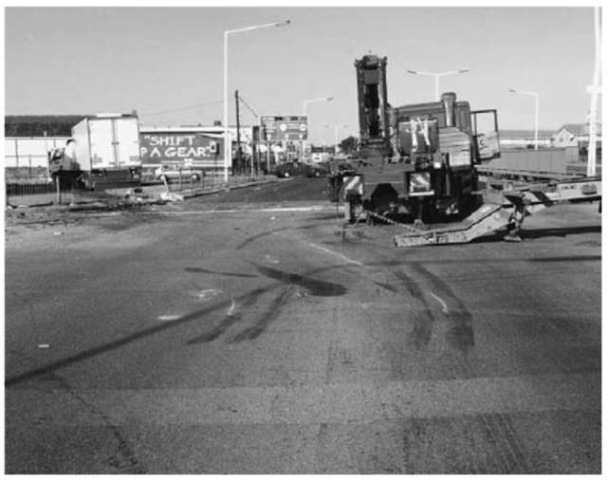
Figure 1 Tire marks scrapes and gouges can be seen in the roadway following this incident involving two goods vehicles.
The investigator needs to understand how the marks were made and as a consequence what that tells them about the incident. Speed estimates are an important component in any analysis of road traffic incidents but care needs to be used in interpreting them. The accident investigator needs to consider how precise is the estimate and at what point in the developing situation was the vehicle traveling at that speed.
Vehicle damage
The damage sustained by the vehicles also provides both qualitative and quantitative information. The nature and position of the damage will indicate the direction of the applied force from which the relative movements of the vehicle or vehicles can be deduced (Fig. 2). If one of the vehicles is stationary the problem is simplified considerably. The extent of the damage can be used to calculate the velocity change caused by the impact. Damage alone does not enable the impact speed to be calculated without some additional information. Again impact with a stationary object is the simplest case to deal with but in other circumstances the post impact movements of the vehicles need to be considered.
It is very easy to misinterpret vehicle damage and the investigator needs to understand the limitations of the model that is being used. The angle of impact can have a significant effect on the answer and care needs to be taken in assessing this. The location and direction of the applied force both affect the precision of the calculation and the investigator needs to understand these effects and interpret the results accordingly. Although reasonably reliable results can be obtained for a collision involving two cars, big differences in the weights of the vehicles can cause unacceptably large errors particularly for the lighter one. This error is proportional to the mass ratio of the vehicles and if this exceeds 2:1 calculated values should be treated with circumspection.
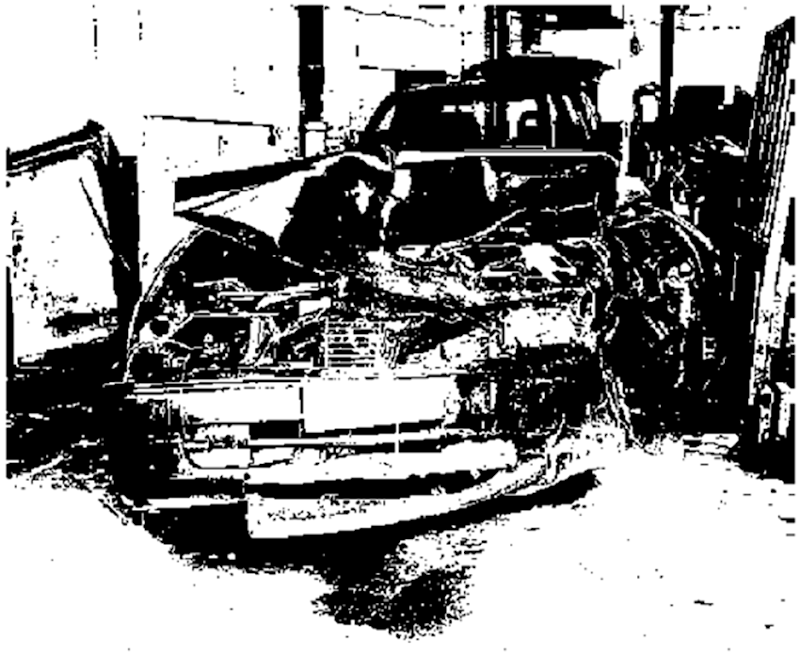
Figure 2 The relative position of this car and the one that struck it can be deduced from the damage to the front. © Metropolitan Police Service.
Pedestrian impacts
Interpreting the results of impacts between pedestrians and cars is particularly difficult and precise estimates of impact speed cannot be made. A variety of techniques are available which provide some guide to the speed of a car which strikes a pedestrian. When the pedestrian is struck by the front of the vehicle empirical relationships between the distance the pedestrian was thrown and the impact speed have been deduced (Fig. 3). Secondly, there is also a statistical correlation between impact speed and the severity of the pedestrian’s injuries. Although this cannot provide unequivocal information about the speed of the vehicle it provides a means of assessing the reliability of other estimates. Finally the nature and location of the damage to the vehicle also provides an indication of the impact speed. None of these methods on their own provide the level of certainty that can be obtained from impacts between two vehicles but in combination they can give a clear indication of likely speed and provide a useful check on other data sources.
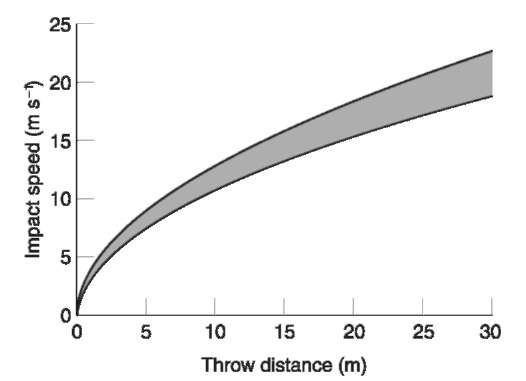
Figure 3 Pedestrian throw distance.
Vehicle condition
Although a very high proportion of road traffic incidents are caused by road users, defective vehicles do contribute to these incidents. The defects can be caused by poor maintenance, prior damage or modifications which are ill conceived and/or poorly executed. An important part of any investigation is the elimination of potential causes and a careful examination of the vehicles involved for defects which might have contributed to the incident should always form a part of the inquiry. This examination is complicated by vehicle damage which coincides with the apparently defective component. This is not always a coincidence as more often than not the failure of the component is a consequence and not a cause of the incident.
Photographs and plans
Photographs and plans are an invaluable source for the investigator and one is not a substitute for the other. If the investigator did not visit the scene, photographs provide a source of information which supplements and amplifies that obtained from witnesses and provide an indispensable aide memoire in other cases. It is not unknown for tire marks which could not be seen clearly at the scene to show up in photographs. However, photographs can distort as well as enhance perceptions. Camera angle and the lens used may distort perspective and liberal use of a flash gun will make the scene appear brighter than it really was.
Plans are only as good as the survey from which they were drawn. However, they should show the relationship between the vehicles, victims, marks and ephemeral evidence and the important features of the scene accurately. They can be used to derive measurements which were not taken at the scene although all important measurements should have been recorded directly at the scene. The relationship between the scale of the plan and the error in such derived values needs to be borne in mind. Rectification programs are now available which allow information to be extracted from photographs and complete plans constructed or missing detail added to existing plans.
Accurate plans are an essential starting point for any simulation program.
Accurate records that can be understood by a layman will be important in any subsequent court proceedings. Accuracy will help to insure that records made by other personnel correspond with the plans.
Speed
Why calculate speed
Why does estimating vehicle speed figure so predominantly in road traffic incident investigation? There are two primary reasons for this. First, speed itself can cause the crash. A good example of this is loss of control when cornering. Such accidents are usually caused by traveling too fast for one or all of these reasons:
• the ability of the driver;
• the performance of the vehicle;
• the condition of the road.
This is most clearly seen and most easily dealt with when the car leaves the curved striated tire scuff marks characteristic of a vehicle cornering at the limits of adhesion.
The other principal reason for wanting an estimate of speed is to use it as a factor in the analysis of the incident. In any collision involving two moving objects the analysis needs to consider their relative movements and intervisibility which requires some knowledge of their velocity.
Vehicle speed
There are many ways in which the speed of a vehicle can be estimated. These include:
• the length of skidmarks;
• the radius of curved scuffmarks;
• vehicle damage.
Skidmarks Skidmarks are left by wheels which are no longer rotating. The marks are characteristic in appearance (Fig. 4) and caused as the wheels slide across the surface of the road. If all the wheels of the vehicle have locked then it is only friction between the tires and the road surface that is slowing the vehicle down. Although a great variety of tires are available those designed for road-going cars are all subject to the same design constraints. As a consequence, the major variables which determine the distance a car takes to skid to a halt are speed and the nature of the road surface. Thus if the coefficient of friction (u) between tires and the road surface can be measured then a reliable estimate of the speed (v) can be calculated from the length of the tire marks (s).
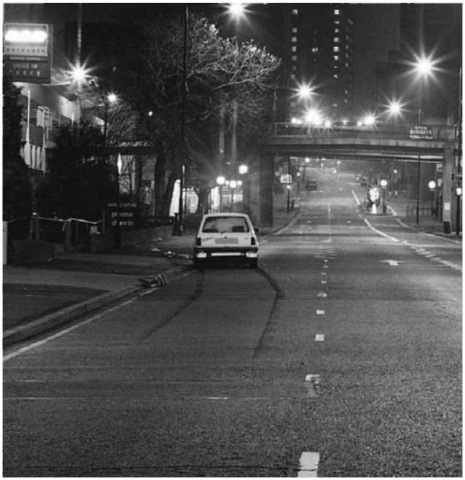
Figure 4 This car left two clearly defined skid marks which deviate sharply to the left part way along. This indicates the point of impact with the victim.
If a car is skidded to a halt from a known speed then:
![]()
where g is the acceleration due to gravity and then the speed of the car leaving the skidmarks is given by:
![]()
Curved scuffmarks The cornering force required to enable a car to follow a curved path is generated by friction between the tires and the road surface. Consequently tire/road friction sets an upper limit on the cornering force which can be generated and hence the speed at which any particular curved path can be followed. If this maximum speed is exceeded then the car side slips and leaves characteristic tire marks. These marks are curved and have a pattern of diagonal striations across them (Fig. 5). The rear wheel on the outside of the curve also tracks outside the front wheel. Once a car starts to leave these scuffmarks the driver has lost control.
Experimental evidence shows that once this point is reached the difference in handling between different vehicles has no effect on the radius of the first part of the scuffmarks which are left. These differences may, however, affect the driver’s ability to regain control of his or her vehicle. The significant variables are the coefficient of friction and the radius of the tire marks.

Figure 5 A vehicle cornering at the limits of adhesion leaves characteristic striated scuff marks which show clearly on the white line in this photograph.
If these are known, the speed of the car can be estimated with a precision of about +10%. The radius (r) of the initial section of the scuffmark can be obtained by simple geometric methods and then:
![tmp2B33_thumb[2] tmp2B33_thumb[2]](http://lh6.ggpht.com/_1wtadqGaaPs/TFBwbignTjI/AAAAAAAALBk/VXHfITysP3s/tmp2B33_thumb2_thumb3.png?imgmax=800)
Vehicle damage At a very simple level there is no surprise in the observation that the faster a car is traveling when it hits something the greater the damage. The observation that the extent of the damage to vehicles of similar size in similar impacts is comparable is perhaps rather more unexpected. The explanation is relatively simple, the manufacturers all have to face the same design constraints and type approval testing. This provides another useful tool for determining the speed of vehicles in road traffic incidents. Vehicle damage alone will not enable the impact speed of a car to be calculated as the extent of the damage depends on the change in speed (Av) brought about by the collision. Thus a car brought to a halt by colliding with a wall at 30 mph will receive the same damage as a car colliding with another, stationary, car of similar mass at 60 mph where the post impact speed of both vehicles will be 30 mph. In all three cases Av is 30 mph.
Although it is possible to calculate Av by hand most of this work is done using computer programs. The data supplied to the program must be accurate and like all computer models the user must understand the limitations. In knowledgeable hands these programs can give accurate and reliable estimates of Av which, coupled with knowledge of the post impact behavior of the car(s), can provide an estimated impact speed.
Pedestrian speed
If the conflict which led to the incident being investigated involved a pedestrian some estimate of the pedestrian’s speed of movement will be required. This can be arrived at in a number of ways. An upper limit on how fast a pedestrian could possibly be moving can be deduced from the world record for the 100 m race. As this is just under 10 s no ordinary pedestrian is likely to run at more than 10ms-1. Of more direct relevance the rule of thumb (Naismith’s Rule) used by hill walkers to calculate point to point times is based on a walking speed of 3miles or 5 kmh-1 – equivalent to 1.4ms-1 – on the level. This is probably a good starting point for any calculations based on a pedestrian’s walking speed.
An alternative approach is to look up previously recorded figures for pedestrian speed. These may provide information about the affects of age, injury and disability on walking speed but some effort will be required to interpret the information given.
Finally the speed at which people similar to the victim move can be measured. This can be tackled in a number of ways. For example covert observation of the pedestrian crossing where the incident occurred will enable an investigator to measure the time taken by people similar to the victim to cross the road. An alternative, particularly where a child running was involved, is to get a number of children of the same age and stature as the victim to run over the same distance and to time them. This should be treated as a game if possible and is best done in consultation with the adult responsible for the children. Although asking the victim to repeat his or her movements has obvious appeal it should be remembered that the victim is not an independent observer of events.
Time and Distance
In many cases the reason for determining the speed of both vehicles and pedestrians is to analyze the movements of the two objects which collided. Such analysis will show where the car might have been when the pedestrian stepped from the kerb or where the vehicle in the main road was when the other vehicle pulled out from the side turning. Comparison of the impact speed of an emerging vehicle with the distance traveled from a stop line to impact may enable the investigator to draw conclusions as to whether or not this vehicle complied with the stop sign. Two other factors, visibility and reaction time, play an important part in assessing the relative movements of vehicles and pedestrians. Without some knowledge of these it is impossible to draw conclusions from the relative movements of the parties to the incident.
Visibility
Before a driver or pedestrian can react to the presence of someone else they have to be able to see them. Although measuring visibility is not difficult it needs to be done with some thought. For example the visibility for one party may not be the same as that for the other. Take the example of a car waiting to emerge from a side turning where visibility is restricted by a fence. If the car has a long bonnet the driver will be some distance behind the give-way or stop line and thus the driver of the oncoming vehicle will be able to see the waiting car before the waiting driver can see the approaching vehicle (Fig. 6).
The height of the vehicle and the driving position and even the height of the pedestrian can have a significant effect on visibility. Thus when measuring visibility the observer should have his or her eyes at the same height as the witness and should be in the same lateral position in the road. As far as possible the target should be as similar as possible to the actual target in the incident.
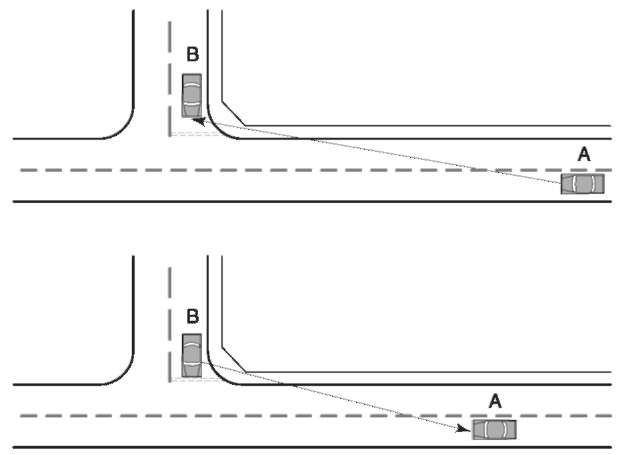
Figure 6 Visibility may not be the same for both vehicles involved in an incident. Top: car A is able to see car B from some distance before it reaches the ‘Give Way’ sign. Bottom: Even at the stop line car B cannot see car A until it is much closer.
Reaction time
A ball rolls into the road with a child in hot pursuit. This is a clearly identifiable hazard but there is an appreciable delay before the approaching car begins to brake. Why was there a delay between the hazard appearing and the driver’s response? Human beings cannot react instantly because a number of cognitive processes have to take place first.
• Perception of the child approaching or entering the carriageway;
• Recognition that a hazard has appeared;
• Decision as to whether to brake or steer;
• Action to apply the brakes.
For most drivers the time taken to complete the last two stages will be very short. In the context of the investigation of dangerous occurrences on the road, however, it is the delay in seeing and recognizing the hazard which gives rise to arguments. This delay between the hazard appearing and action commencing is called reaction or perception-response time.
Although defining reaction time is a necessary preliminary to measuring it, actual measurement is difficult. Most systems designed to measure reaction time modify the value being measured by warning the driver to expect something and telling him or her what action to take. Many tests bear little resemblance to real driving conditions. The most widely known estimate of reaction time in the UK is that used to derive the thinking distance component of stopping distance in the UK’s Highway Code. The origin of this figure, 0.68 s, is lost in the mists of time but it is probably significant that it amounts to 1 foot of thinking distance for every mile per hour of speed. It is unrealistically short for normal drivers in real driving conditions.
It is difficult to set up an experiment which measures driver reaction time without having to tell the driver what is happening. One attempt to do so used a driving simulator for what were ostensibly tests quite unconnected to reaction time. Eleven drivers were tested who fell into two groups with mean reaction times of 0.83 s and 1.13 s. The slowest driver took 1.43 s. Alcohol and some other drugs tend to extend a driver’s reaction time, often quite significantly. Perception-response time is discussed at some length in the literature.
Although driver reaction time is a complex problem in cognitive psychology, investigation of road traffic incidents requires an understanding of the concept and the range of values which the normally alert driver might achieve. The effect of expectation on response should not be overlooked. Drivers do not expect pedestrians to be crossing multi-lane dual carriageways and thus react slowly when they do.
Interpretation
General considerations
The critical part of any investigation is the collation and interpretation of the information obtained. This should be tackled in a logical and methodical manner and will be an iterative process which should have started as the information is collected. A growing understanding of the incident will have directed the investigator’s inquiry to insure that the right information is obtained and nothing is overlooked. Care must be taken not to exclude alternative plausible explanations until sufficient information has been collected to justify ignoring them.
All evidence particularly that of eye witnesses should be considered critically.
• Could the witness see?
• What attracted the witness’s attention?
• Are the plans accurate?
• Do the photographs give the correct impression with no distortion of perspective.
• Is what the witness saw possible?
• What is the precision of the calculations and how in consequence should they be interpreted?
Analysis of the information will go through a number of overlapping stages. Information obtained from one stage may well modify that obtained from an earlier stage which will need to be re-assessed. By the end of this iterative process the investigator will have firm factual and logical foundation for his or her conclusions.
Analytical process
There is no one correct way of analyzing an incident but all of the following steps should be included.
Plans, photographs and observations Good plans and photographs enable the investigator to get a clear picture of the scene, an essential first step in the analysis of the incident. Plans and photographs:
• provide a vital aid to understanding what the witnesses are saying;
• show the relationship between marks, participants and the environment;
• allow the investigator to develop his her own interpretation of events;
• may be used as a source of data.
The eye witnesses The evidence of eye witnesses needs to reviewed carefully. However, with care they can provide reliable evidence which can be obtained in no other way. The investigator needs to consider the following.
• What do they say and are they consistent?
• If, as is normal, they disagree are there any areas of agreement?
• Are there obvious explanations for disagreements (e.g. their viewpoint)?
• Is there information which will be required for subsequent analysis? e.g. the state of traffic signals; the direction of travel and speed of pedestrians and vehicles.
Skidmarks and scuffmarks Ephemeral evidence left at the scene is one of the basic building blocks of a successful reconstruction of a road traffic incident.
• What marks have been left on the road surface?
• What can be deduced about the movements of vehicles and pedestrians from them?
• Can they be used to estimate speed?
The vehicle(s) The condition of the vehicle(s) involved in the incident is important for two reasons.
• Is the vehicle itself a cause of the incident?
• Can anything be deduced about impact speed?
Calculations Calculations based on observations and measurements are inevitably multistage processes which may involve re-evaluation of the other information between stages:
• Estimate of vehicle speed from tire marks, damage etc.
• Estimate time taken for:
• the pedestrian to cross the road;
• another vehicle to emerge from a side road;
• a vehicle to skid to impact.
• Investigate questions of intervisibility or reaction time.
With all calculations the investigator needs to be aware of:
• the accuracy and precision of the result;
• the sensitivity of the result to changes in input information.
At each stage other information should be re-evaluated and the direction of the investigation reviewed. What should be done and in what order will depend on the circumstances, but at the end of one or more iterations the investigator should have a clear understanding of the incident and how it developed and be in a position to explain it in clear, simple language.
Conclusion
Throughout any analysis of an incident the investigator should always search for ways of corroborating one source of information with another. At the end of the process the explanation of the sequence of events leading up to and through the incident should be internally consistent and include all the known data. If some data have been excluded the investigator should provide reasons – no data should just be ignored. Finally, the investigator must report his or her findings clearly and simply setting out the information available, logical process gone through, and the conclusions reached. Just as photographs, plans and other illustrations can assist the investigator to understand what happened they can be used to support and amplify the report. The old adage that a picture is worth a thousand words remains true.
The primary reason for investigating road traffic incidents is to learn what lessons they teach and thereby improve road safety. The investigator endeavors to establish what happened, why it happened and how repetition can be avoided. By learning from experience the UK has reduced annual road traffic fatalities from around 5600 to around 3600 in 13 years. Further significant reduction in this figure must be achieved and thorough, knowledgeable investigation of all incidents and application of the lessons learnt will continue to play a significant part in achieving this goal.
